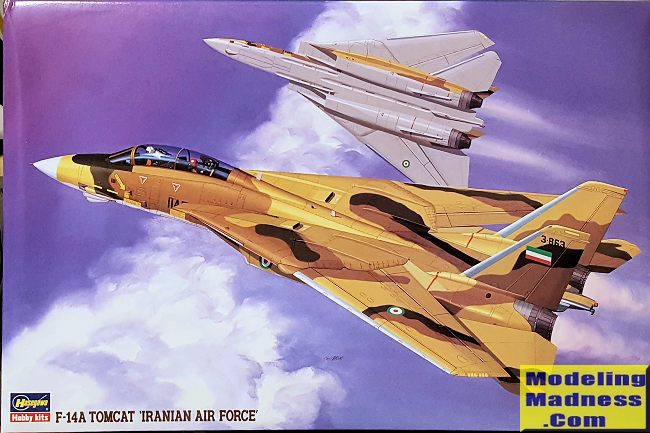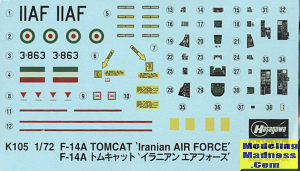
Hasegawa 1/72 F-14A Tomcat 'Iranian Air Force'
| KIT #: | 04065 (K105) |
| PRICE: | $26.95 in 1994 |
| DECALS: | Two options |
| REVIEWER: | Scott Van Aken |
| NOTES: | 1994 release |

| HISTORY |
The Grumman F-14 Tomcat is a supersonic, twinjet, two-seat, variable-sweep wing fighter aircraft. The Tomcat was developed for the United States Navy's Naval Fighter Experimental (VFX) program following the collapse of the F-111B project. The F-14 was the first of the American teen-series fighters which were designed incorporating the experience of air combat against MiG fighters during the Vietnam War.
The F-14 first flew in December 1970 and made its first deployment in 1974 with the U.S. Navy aboard USS Enterprise (CVN-65), replacing the McDonnell Douglas F-4 Phantom II. The F-14 served as the U.S. Navy's primary maritime air superiority fighter, fleet defense interceptor and tactical reconnaissance platform. In the 1990s, it added the Low Altitude Navigation and Targeting Infrared for Night (LANTIRN) pod system and began performing precision ground-attack missions.
The Tomcat was retired from the U.S. Navy's active fleet on 22 September 2006, having been supplanted by the Boeing F/A-18E/F Super Hornet. As of 2012, the F-14 was only in service with the Islamic Republic of Iran Air Force, having been exported to Iran in 1976, when the U.S. had amicable diplomatic relations with Iran. A fair number of these are still in service.
| THE KIT |
 Hasegawa's
original tool F-14A was released about 1978 and was immediately heralded as the
best Tomcat around in its scale. It had the sort of detail that was missing in
the earlier release Monogram and Airfix kits, which, at the time, was raised
panel lines. The kit contains a fair cockpit with a bucket, two somewhat generic
seats control sticks and pilot figures. The instrument and consoles require
decals for detail, something still quite common with 1/72 kits. The interior
fits atop the nose gear well. Typical of the 'blended wing' kits like the F-15
and F-16, the forward fuselage is split vertically and the rest is horizontal.
In the case of the Tomcat, this is to allow its wings to move fore and aft.
Hasegawa's
original tool F-14A was released about 1978 and was immediately heralded as the
best Tomcat around in its scale. It had the sort of detail that was missing in
the earlier release Monogram and Airfix kits, which, at the time, was raised
panel lines. The kit contains a fair cockpit with a bucket, two somewhat generic
seats control sticks and pilot figures. The instrument and consoles require
decals for detail, something still quite common with 1/72 kits. The interior
fits atop the nose gear well. Typical of the 'blended wing' kits like the F-15
and F-16, the forward fuselage is split vertically and the rest is horizontal.
In the case of the Tomcat, this is to allow its wings to move fore and aft.
It was decided in the late 80s/early 90s to give modelers a new tool kit that provided more detail over the original. In this kit, you had the ability to deploy the slats and flaps with the wings in the forward position. The use of inserts provides the proper gun vent detail and you have the ability to change the rear fuselage piece as these items changed during the development of the aircraft. Also included in this kit is a photo etch fret that is basically used to gussy up the cockpit. Decals are also included.
You can also pose the speed brakes open or closed if you wish and you have an optional nose gear which offers both the normal and lowered position. The tail hook is posable and you have a separate windscreen and canopy so you can have the canopy open if you wish. Landing gear is very nicely done. The kit provides wing pylons along with Phoenix pallets. Of course, no missiles are included so you will have to buy the additional Weapons Set or dig through your spares box for these items.
 Instructions
seem to be done for another kit as they provide differences for four options.
However, only one is shown in the markings guide. This is the desert camouflage
used on these planes for many years. The option is for the box art plane. Decals
are nicely done, but their age may be working against them so having alternates
available might be a good idea.
Instructions
seem to be done for another kit as they provide differences for four options.
However, only one is shown in the markings guide. This is the desert camouflage
used on these planes for many years. The option is for the box art plane. Decals
are nicely done, but their age may be working against them so having alternates
available might be a good idea.
| CONCLUSIONS |
Despite these being fairly pricey when new, the Hasegawa 1/72 Tomcats are still very much worth building when you can find them at a more reasonable price.
| REFERENCES |
http://en.wikipedia.org/wiki/Grumman_F-14_Tomcat
May 2022 Copyright ModelingMadness.com. All rights reserved. No
reproduction in part or in whole without express permission from the editor. If you would like your product reviewed fairly and fairly quickly, please
contact
the editor
or see other details in the
Note to
Contributors.